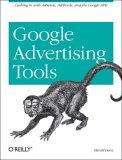
Google Advertising Tools : Cashing in with AdSense, AdWords, and the Google APIs by Harold Davis is from O’Reilly (2006). The book covers a wide range of information meant to satisfy everyone from the neophyte advertiser to the web development professional. The book is divided into four major sections. Part I is Making Money with Your Web Site—a basic introduction to advertising terminology, advertising programs, and site planning.
Part II is Getting the Most of AdSense. Instructions for setting up a Google AdSense program are step-by-step and include helpful information about how Google searches work. This section explains tracking search performance. In Part III, Working with AdWords, the instructions again take you step-by-step through account setup and account types. This section contains advice on how to optimize ads, target sites, and use AdWords reports to improve your earnings.
Part IV is Using the AdWords API. This part of the book is aimed at programmers and tells about using the AdWords API with web services and PHP, as well as how to use the AdWords hierarchy and keyword estimation.
Casual bloggers, web entrepreneurs, and web developers who want to make money from a web site can all gain from this book.
As for teaching, if you are teaching a class about economics on the web, this is a valuable resource.